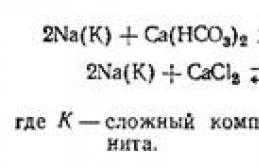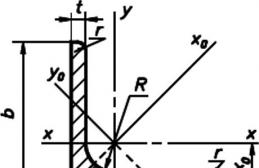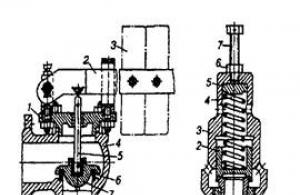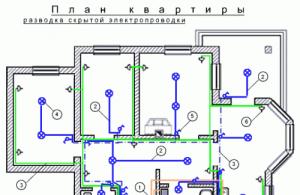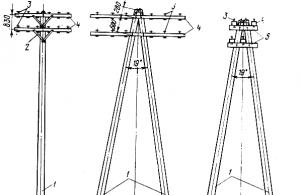The necessary explanations have been given, let's get to the point.
Transistors. Definition and history
Transistor- an electronic semiconductor device in which the current in a circuit of two electrodes is controlled by a third electrode. (transistors.ru)
Field-effect transistors were the first to be invented (1928), and bipolar transistors appeared in 1947 at Bell Labs. And it was, without exaggeration, a revolution in electronics.
Very quickly, transistors replaced vacuum tubes in various electronic devices. In this regard, the reliability of such devices has increased and their size has decreased significantly. And to this day, no matter how “sophisticated” the microcircuit is, it still contains many transistors (as well as diodes, capacitors, resistors, etc.). Only very small ones.
By the way, initially “transistors” were resistors whose resistance could be changed using the amount of applied voltage. If we ignore the physics of processes, then a modern transistor can also be represented as a resistance that depends on the signal supplied to it.
What is the difference between field-effect and bipolar transistors? The answer lies in their very names. In a bipolar transistor, charge transfer involves And electrons, And holes (“encore” - twice). And in the field (aka unipolar) - or electrons, or holes.
Also, these types of transistors differ in application areas. Bipolar ones are used mainly in analog technology, and field ones - in digital technology.
And finally: the main area of application of any transistors- strengthening of a weak signal due to an additional power source.
Bipolar transistor. Principle of operation. Main characteristics


A bipolar transistor consists of three regions: emitter, base and collector, each of which is supplied with voltage. Depending on the type of conductivity of these areas, n-p-n and p-n-p transistors are distinguished. Typically the collector area is wider than the emitter area. The base is made of a lightly doped semiconductor (which is why it has high resistance) and is made very thin. Since the emitter-base contact area is significantly smaller than the base-collector contact area, it is impossible to swap the emitter and collector by changing the connection polarity. Thus, the transistor is an asymmetrical device.
Before considering the physics of how a transistor operates, let's outline the general problem. 
It is as follows: a strong current flows between the emitter and collector ( collector current), and between the emitter and base there is a weak control current ( base current). The collector current will change depending on the change in base current. Why?
Let's consider the p-n junctions of the transistor. There are two of them: emitter-base (EB) and base-collector (BC). In the active mode of operation of the transistor, the first of them is connected with forward bias, and the second with reverse bias. What happens at the p-n junctions? For greater certainty, we will consider an n-p-n transistor. For p-n-p everything is similar, only the word “electrons” needs to be replaced with “holes”.
Since the EB junction is open, electrons easily “run across” to the base. There they partially recombine with holes, but O Most of them, due to the small thickness of the base and its low doping, manage to reach the base-collector transition. Which, as we remember, is reverse biased. And since electrons in the base are minority charge carriers, the electric field of the transition helps them overcome it. Thus, the collector current is only slightly less than the emitter current. Now watch your hands. If you increase the base current, the EB junction will open more strongly, and more electrons will be able to slip between the emitter and collector. And since the collector current is initially greater than the base current, this change will be very, very noticeable. Thus, the weak signal received at the base will be amplified. Once again, a large change in collector current is a proportional reflection of a small change in base current.
I remember that the principle of operation of a bipolar transistor was explained to my classmate using the example of a water tap. The water in it is the collector current, and the base control current is how much we turn the knob. A small force (control action) is enough to increase the flow of water from the tap.
In addition to the processes considered, a number of other phenomena can occur at the p-n junctions of the transistor. For example, with a strong increase in voltage at the base-collector junction, avalanche charge multiplication may begin due to impact ionization. And coupled with the tunnel effect, this will give first an electrical breakdown, and then (with increasing current) a thermal breakdown. However, thermal breakdown in a transistor can occur without electrical breakdown (i.e., without increasing the collector voltage to breakdown voltage). One excessive current through the collector will be enough for this.
Another phenomenon is due to the fact that when the voltages on the collector and emitter junctions change, their thickness changes. And if the base is too thin, then a closing effect may occur (the so-called “puncture” of the base) - a connection between the collector junction and the emitter junction. In this case, the base region disappears and the transistor stops working normally.
The collector current of the transistor in the normal active mode of operation of the transistor is greater than the base current by a certain number of times. This number is called current gain and is one of the main parameters of the transistor. It is designated h21. If the transistor is turned on without load on the collector, then at a constant collector-emitter voltage the ratio of the collector current to the base current will give static current gain. It can be equal to tens or hundreds of units, but it is worth considering the fact that in real circuits this coefficient is smaller due to the fact that when the load is turned on, the collector current naturally decreases.
The second important parameter is transistor input resistance. According to Ohm's law, it is the ratio of the voltage between the base and emitter to the control current of the base. The larger it is, the lower the base current and the higher the gain.
The third parameter of a bipolar transistor is voltage gain. It is equal to the ratio of the amplitude or effective values of the output (emitter-collector) and input (base-emitter) alternating voltages. Since the first value is usually very large (units and tens of volts), and the second is very small (tenths of volts), this coefficient can reach tens of thousands of units. It is worth noting that each base control signal has its own voltage gain.
Transistors also have frequency response, which characterizes the transistor’s ability to amplify a signal whose frequency approaches the cut-off amplification frequency. The fact is that as the frequency of the input signal increases, the gain decreases. This is due to the fact that the time of occurrence of the main physical processes (the time of movement of carriers from the emitter to the collector, the charge and discharge of capacitive barrier junctions) becomes commensurate with the period of change of the input signal. Those. the transistor simply does not have time to react to changes in the input signal and at some point simply stops amplifying it. The frequency at which this happens is called boundary.
Also, the parameters of the bipolar transistor are:
- reverse current collector-emitter
- on time
- reverse collector current
- maximum permissible current
The symbols for n-p-n and p-n-p transistors differ only in the direction of the arrow indicating the emitter. It shows how current flows in a given transistor.
Operating modes of a bipolar transistor
The option discussed above represents the normal active mode of operation of the transistor. However, there are several more combinations of open/closed p-n junctions, each of which represents a separate mode of operation of the transistor.- Inverse active mode. Here the BC transition is open, but on the contrary, the EB is closed. The amplification properties in this mode, of course, are worse than ever, so transistors are used very rarely in this mode.
- Saturation mode. Both crossings are open. Accordingly, the main charge carriers of the collector and emitter “run” to the base, where they actively recombine with its main carriers. Due to the resulting excess of charge carriers, the resistance of the base and p-n junctions decreases. Therefore, a circuit containing a transistor in saturation mode can be considered short-circuited, and this radio element itself can be represented as an equipotential point.
- Cut-off mode. Both transitions of the transistor are closed, i.e. the current of the main charge carriers between the emitter and collector stops. Flows of minority charge carriers create only small and uncontrollable thermal transition currents. Due to the poverty of the base and transitions with charge carriers, their resistance increases greatly. Therefore, it is often believed that a transistor operating in cutoff mode represents an open circuit.
- Barrier mode In this mode, the base is directly or through a low resistance connected to the collector. A resistor is also included in the collector or emitter circuit, which sets the current through the transistor. This creates the equivalent of a diode circuit with a resistor in series. This mode is very useful, as it allows the circuit to operate at almost any frequency, over a wide temperature range and is undemanding to the parameters of the transistors.
Switching circuits for bipolar transistors
Since the transistor has three contacts, in general, power must be supplied to it from two sources, which together produce four outputs. Therefore, one of the transistor contacts has to be supplied with a voltage of the same sign from both sources. And depending on what kind of contact it is, there are three circuits for connecting bipolar transistors: with a common emitter (CE), a common collector (OC) and a common base (CB). Each of them has both advantages and disadvantages. The choice between them is made depending on which parameters are important to us and which can be sacrificed.
Connection circuit with common emitter

This circuit provides the greatest gain in voltage and current (and hence in power - up to tens of thousands of units), and therefore is the most common. Here the emitter-base junction is turned on directly, and the base-collector junction is turned on reversely. And since both the base and the collector are supplied with voltage of the same sign, the circuit can be powered from one source. In this circuit, the phase of the output AC voltage changes relative to the phase of the input AC voltage by 180 degrees.
But in addition to all the goodies, the OE scheme also has a significant drawback. It lies in the fact that an increase in frequency and temperature leads to a significant deterioration in the amplification properties of the transistor. Thus, if the transistor must operate at high frequencies, then it is better to use a different switching circuit. For example, with a common base.
Connection diagram with a common base

This circuit does not provide significant signal amplification, but is good at high frequencies, since it allows more full use of the frequency response of the transistor. If the same transistor is connected first according to a circuit with a common emitter, and then with a common base, then in the second case there will be a significant increase in its cutoff frequency of amplification. Since with such a connection the input impedance is low and the output impedance is not very high, transistor cascades assembled according to the OB circuit are used in antenna amplifiers, where the characteristic impedance of the cables usually does not exceed 100 Ohms.
In a common-base circuit, the signal phase does not invert, and the noise level at high frequencies is reduced. But, as already mentioned, its current gain is always slightly less than unity. True, the voltage gain here is the same as in a circuit with a common emitter. The disadvantages of a common base circuit also include the need to use two power supplies.
Connection diagram with a common collector

The peculiarity of this circuit is that the input voltage is completely transmitted back to the input, i.e. the negative feedback is very strong.
Let me remind you that negative feedback is such feedback in which the output signal is fed back to the input, thereby reducing the level of the input signal. Thus, automatic adjustment occurs when the input signal parameters accidentally change
The current gain is almost the same as in the common emitter circuit. But the voltage gain is small (the main drawback of this circuit). It approaches unity, but is always less than it. Thus, the power gain is equal to only a few tens of units.
In a common collector circuit, there is no phase shift between the input and output voltage. Since the voltage gain is close to unity, the output voltage matches the input voltage in phase and amplitude, i.e., repeats it. That is why such a circuit is called an emitter follower. Emitter - because the output voltage is removed from the emitter relative to the common wire.
This connection is used to match transistor stages or when the input signal source has a high input impedance (for example, a piezoelectric pickup or a condenser microphone).
Two words about cascades
It happens that you need to increase the output power (i.e. increase the collector current). In this case, parallel connection of the required number of transistors is used.
Naturally, they should be approximately the same in characteristics. But it must be remembered that the maximum total collector current should not exceed 1.6-1.7 of the maximum collector current of any of the cascade transistors.
However (thanks to wrewolf for the note), this is not recommended in the case of bipolar transistors. Because two transistors, even of the same type, are at least slightly different from each other. Accordingly, when connected in parallel, currents of different magnitudes will flow through them. To equalize these currents, balanced resistors are installed in the emitter circuits of the transistors. The value of their resistance is calculated so that the voltage drop across them in the operating current range is at least 0.7 V. It is clear that this leads to a significant deterioration in the efficiency of the circuit.
There may also be a need for a transistor with good sensitivity and at the same time good gain. In such cases, a cascade of a sensitive but low-power transistor (VT1 in the figure) is used, which controls the power supply of a more powerful fellow (VT2 in the figure). 
Other applications of bipolar transistors
Transistors can be used not only in signal amplification circuits. For example, due to the fact that they can operate in saturation and cutoff modes, they are used as electronic keys. It is also possible to use transistors in signal generator circuits. If they operate in the key mode, then a rectangular signal will be generated, and if in the amplification mode, then a signal of arbitrary shape, depending on the control action.Marking
Since the article has already grown to an indecently large volume, at this point I will simply give two good links, which describe in detail the main marking systems for semiconductor devices (including transistors): http://kazus.ru/guide/transistors/mark_all .html and .xls file (35 kb).Helpful comments:
http://habrahabr.ru/blogs/easyelectronics/133136/#comment_4419173
Tags: Add tags
Transistor(transistor) - a semiconductor element with three terminals (usually), one of which ( collector) a strong current is supplied, and the other ( base) served weak ( control current). At a certain strength of the control current, it is as if a valve “opens” and the current from the collector starts to flow on third output ( emitter).

That is, a transistor is a kind of valve, which, at a certain current strength, sharply reduces the resistance and sends the current further (from the collector to the emitter). This happens because under certain conditions, holes that have an electron lose it, accepting a new one, and so on in a circle. If no electric current is applied to the base, the transistor will be in a balanced state and will not pass current to the emitter.

In modern electronic chips, the number of transistors numbers in the billions. They are used primarily for calculations and consist of complex connections.
Semiconductor materials mainly used in transistors are: silicon, gallium arsenide And germanium. There are also transistors carbon nanotubes, transparent for displays LCD And polymer(the most promising).
Types of transistors:
Bipolar– transistors in which charge carriers can be both electrons and “holes”. Current can flow like towards the emitter, so towards the collector. To control the flow, certain control currents are used.
– widespread devices in which the electrical flow is controlled through an electric field. That is, when a larger field is formed, more electrons are captured by it and cannot transfer charges further. That is, this is a kind of valve that can change the amount of transferred charge (if the field-effect transistor is controlled p—n— transition). A distinctive feature of these transistors is their high input voltage and high voltage gain.
Combined– transistors with combined resistors, or other transistors in one housing. They serve for various purposes, but mainly to increase the current gain.
Subtypes:
Bio-transistors– are based on biological polymers that can be used in medicine and biotechnology without harm to living organisms. Studies have been conducted on metalloproteins, chlorophyll A (derived from spinach), and tobacco mosaic virus.
Single-electron transistors– were first created by Russian scientists in 1996. They could work at room temperature, unlike their predecessors. The operating principle is similar to a field-effect transistor, but more subtle. The signal transmitter is one or more electrons. This transistor is also called a nano- and quantum transistor. Using this technology, in the future they hope to create transistors with a size less than 10 nm, based graphene.
What are transistors used for?
Transistors are used in amplification circuits, lamps, electric motors and other devices where rapid changes in current or position are required onoff. The transistor can limit the current or smoothly, or by method pulse—pause. The second is more often used for -control. Using a powerful power source, it conducts it through itself, regulating it with a weak current.
If the current is not enough to turn on the transistor circuit, then use several transistors with greater sensitivity, connected in a cascade manner.
Powerful transistors connected in one or more packages are used in fully digital amplifiers based on. They often need additional cooling. In most schemes, they work in key mode(in switch mode).
Transistors are also used in power systems, both digital and analog ( motherboards, video cards, Power supplies&etc).
Central processors, also consist of millions and billions of transistors, connected in a certain order for specialized calculations.

Each group of transistors encodes the signal in a certain way and transmits it further for processing. All types and ROM memories also consist of transistors.
All achievements of microelectronics would be practically impossible without the invention and use of transistors. It is difficult to imagine at least one electronic device without at least one transistor.
Electronics surround us everywhere. But almost no one thinks about how this whole thing works. It's actually quite simple. This is exactly what we will try to show today. Let's start with such an important element as the transistor. We'll tell you what it is, what it does, and how the transistor works.
What is a transistor?
Transistor– a semiconductor device designed to control electric current.
Where are transistors used? Yes everywhere! Almost no modern electrical circuit can do without transistors. They are widely used in the production of computer equipment, audio and video equipment.
Times when Soviet microcircuits were the largest in the world, have passed, and the size of modern transistors is very small. Thus, the smallest devices are on the order of a nanometer in size!
Console nano- denotes a value of the order of ten to the minus ninth power.
However, there are also giant specimens that are used primarily in the fields of energy and industry.

There are different types of transistors: bipolar and polar, direct and reverse conduction. However, the operation of these devices is based on the same principle. A transistor is a semiconductor device. As is known, in a semiconductor the charge carriers are electrons or holes.
The region with excess electrons is indicated by the letter n(negative), and the region with hole conductivity is p(positive).
How does a transistor work?
To make everything very clear, let's look at the work bipolar transistor (the most popular type).
(hereinafter referred to simply as a transistor) is a semiconductor crystal (most often used silicon or germanium), divided into three zones with different electrical conductivities. The zones are named accordingly collector, base And emitter. The device of the transistor and its schematic representation are shown in the figure below

Separate forward and reverse conduction transistors. P-n-p transistors are called forward conduction transistors, and n-p-n transistors are called reverse conduction transistors.

Now let's talk about the two operating modes of transistors. The operation of the transistor itself is similar to the operation of a water tap or valve. Only instead of water there is electric current. There are two possible states of the transistor - operating (transistor open) and rest state (transistor closed).
What does it mean? When the transistor is turned off, no current flows through it. In the open state, when a small control current is applied to the base, the transistor opens and a large current begins to flow through the emitter-collector.
Physical processes in a transistor
And now more about why everything happens this way, that is, why the transistor opens and closes. Let's take a bipolar transistor. Let it be n-p-n transistor.
If you connect a power source between the collector and the emitter, the collector's electrons will begin to be attracted to the positive, but there will be no current between the collector and the emitter. This is hampered by the base layer and the emitter layer itself.

If you connect an additional source between the base and emitter, electrons from the n region of the emitter will begin to penetrate into the base region. As a result, the base area will be enriched with free electrons, some of which will recombine with holes, some will flow to the plus of the base, and some (most) will go to the collector.
Thus, the transistor turns out to be open, and the emitter-collector current flows in it. If the base voltage is increased, the collector-emitter current will also increase. Moreover, with a small change in the control voltage, a significant increase in the current through the collector-emitter is observed. It is on this effect that the operation of transistors in amplifiers is based.

That, in a nutshell, is the essence of how transistors work. Need to calculate a power amplifier using bipolar transistors overnight, or do laboratory work to study the operation of a transistor? This is not a problem even for a beginner if you use the help of our student service specialists.
Don't hesitate to seek professional help in important matters like studying! And now that you already have an idea about transistors, we suggest you relax and watch the video by Korn “Twisted transistor”! For example, you decide to contact the Correspondence Student.
A transistor belongs to the category of semiconductor devices. In electrical engineering it is used as a generator and amplifier of electrical oscillations. The basis of the device is a crystal located in the housing. To make a crystal, a special semiconductor material is used, whose properties are in an intermediate position between an insulator and a conductor. The transistor is used in radio and electronic circuits. These devices can be... Each of them has its own parameters and characteristics.
Features of bipolar transistors
Electric current in bipolar transistors is generated by electric charges that have positive and negative polarity. Holes carry positive polarity and electrons carry negative polarity. For this type of device, germanium or silicon crystals are used, which have individual characteristics that are taken into account when creating electronic circuits.
The crystal is based on ultrapure materials. Special impurities are added to them in precise dosages. They influence the appearance of electronic or hole conductivity in the crystal. They are designated respectively as n- or p-conductivity. A base is formed, which is one of the electrodes. Special impurities introduced into the crystalline surface change the conductivity of the base to the opposite value. As a result, n-p-n or p-n-p zones are formed, to which the terminals are connected. Thus, a transistor is created.

The source of charge carriers is called an emitter, and the collector of charge carriers is a collector. Between them there is a zone that acts as a base. The terminals of the device are named according to the connected electrodes. When an input signal in the form of a small electrical voltage arrives at the emitter, current will flow in the circuit between it and the collector. The shape of this current coincides with the input signal, but its value increases significantly. This is where the amplifying properties of the transistor lie.
Operation of a field effect transistor
In field-effect transistors, the directional movement of electrons or holes is formed under the influence of an electric field, which is created at the third electrode by the applied voltage. Carriers come out of one electrode, which is why it is called a source. The second electrode, which receives charges, is called the drain. The third electrode, which controls the movement of particles, is called a gate. The conductive section bounded by the drain and source is called a channel, therefore these devices are also known as channel devices. The channel resistance changes under the influence of voltage generated at the gate. This factor affects the electric current flowing through the channel.

The type of charge carriers affects the characteristics. The directional movement of electrons occurs in the n-channel, and holes move in the p-channel. Thus, the current appears under the influence of carriers with only one sign. This is the main difference between field-effect and bipolar transistors.
The operating principle of each field effect transistor is unipolar current, requiring a constant voltage to provide the initial bias. The polarity value depends on the type of channel, and the voltage is related to a particular type of device. In general, they are reliable in operation, can operate in a wide frequency range, and have a high input impedance.
In this article we will try to describe principle of operation The most common type of transistor is bipolar. Bipolar transistor is one of the main active elements of radio-electronic devices. Its purpose is to work to amplify the power of the electrical signal arriving at its input. Power amplification is carried out using an external energy source. A transistor is a radio-electronic component with three terminals
Design feature of a bipolar transistor
To produce a bipolar transistor, you need a semiconductor of hole or electronic conductivity type, which is obtained by diffusion or alloying with acceptor impurities. As a result, regions with polar conductivities are formed on both sides of the base.

Bipolar transistors are of two types based on conductivity: n-p-n and p-n-p. The operating rules that govern a bipolar transistor having n-p-n conductivity (for p-n-p it is necessary to change the polarity of the applied voltage):
- The positive potential at the collector is more important compared to the emitter.
- Any transistor has its own maximum permissible parameters Ib, Ik and Uke, exceeding which is in principle unacceptable, since this can lead to destruction of the semiconductor.
- The base-emitter and base-collector terminals function like diodes. As a rule, the diode in the base-emitter direction is open, and in the base-collector direction it is biased in the opposite direction, that is, the incoming voltage interferes with the flow of electric current through it.
- If steps 1 to 3 are completed, then the current Ik is directly proportional to the current Ib and has the form: Ik = he21*Ib, where he21 is the current gain. This rule characterizes the main quality of the transistor, namely that the low base current controls the powerful collector current.
For different bipolar transistors of the same series, the he21 indicator can fundamentally vary from 50 to 250. Its value also depends on the flowing collector current, the voltage between the emitter and the collector, and on the ambient temperature.

Let's study rule No. 3. It follows from this that the voltage applied between the emitter and the base should not be significantly increased, since if the base voltage is 0.6...0.8 V greater than the emitter (forward voltage of the diode), then an extremely large current will appear. Thus, in a working transistor, the voltages at the emitter and base are interconnected according to the formula: Ub = Ue + 0.6V (Ub = Ue + Ube)
Let us remind you once again that all these points apply to transistors with n-p-n conductivity. For the p-n-p type everything should be reversed.
You should also pay attention to the fact that the collector current has no connection with the conductivity of the diode, since, as a rule, reverse voltage is supplied to the collector-base diode. In addition, the current flowing through the collector depends very little on the potential on the collector (this diode is similar to a small current source)
When the transistor is turned on in amplification mode, the emitter junction is open and the collector junction is closed. This is achieved by connecting power supplies.

Since the emitter junction is open, the emitter current will pass through it, arising due to the transition of holes from the base to the emitter, as well as electrons from the emitter to the base. Thus, the emitter current contains two components - hole and electron. The injection ratio determines the efficiency of the emitter. Charge injection is the transfer of charge carriers from the zone where they were the majority to the zone where they become minority.
In the base, electrons recombine, and their concentration in the base is replenished from the plus of the EE source. As a result, a rather weak current will flow in the base electrical circuit. The remaining electrons that did not have time to recombine in the base, under the accelerating influence of the field of the locked collector junction, as minority carriers, will move into the collector, creating a collector current. The transfer of charge carriers from the zone where they were minority to the zone where they become majority is called extraction of electrical charges.

